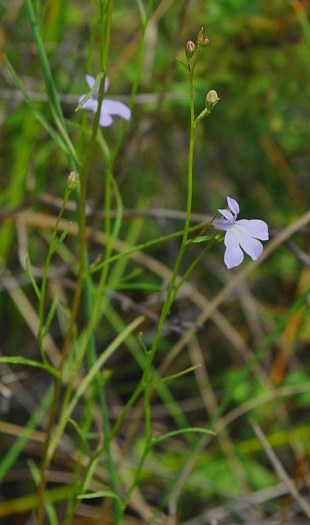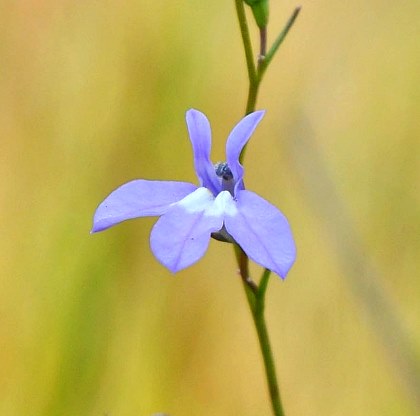 Description:
This perennial wildflower is ½-1½' tall and either branched or
unbranched. The slender stem(s) is light green to purple. Alternate
leaves about ½-2" long and 1-5 mm. across occur along the stem(s). The
leaves are light to medium green, linear to linear-oblong in shape, and
usually smooth along their margins. The central stem and any lateral
stems terminate in racemes of flowers; the flowers are distributed
sparsely along the rachis of each raceme. Each flower is ¼-½" across,
consisting of a 2-lipped tubular corolla that is light blue (rarely
white), a bell-shaped (campanulate) calyx with 5 slender teeth that
are light green to purple, 5 stamens, and a 2-celled ovary with a
single
style. The stamens tightly surround the style. The upper lip of the
corolla is divided into 2 small narrow lobes, while the lower lip is
divided into 3 large lobes. At the base of the corolla's lower lip,
there is a conspicuous patch of white; sometimes this patch becomes
yellow along its upper boundary near the throat of the corolla. The
corolla is hairless throughout, while sometimes the bottom of the calyx
is pubescent. The slender pedicels of the flowers are ¼-1" long; they
are light green to purple and either glabrous or minutely pubescent.
Toward the middle of each pedicel there is a tiny linear bractlet; at
the base of each pedicel there is a linear bract that is about the same
length as the pedicel. The blooming period occurs from mid-summer to
early fall and lasts about 1 month. Afterwards, the flowers are
replaced by seed capsules about 4 mm. across; each capsule splits open
at its apex to release numerous tiny seeds that are narrowly oblongoid
and compressed (somewhat flattened) in shape. The seeds are small
enough to be blown about by the wind or transported by water. The root
system is shallow and fibrous.
Description:
This perennial wildflower is ½-1½' tall and either branched or
unbranched. The slender stem(s) is light green to purple. Alternate
leaves about ½-2" long and 1-5 mm. across occur along the stem(s). The
leaves are light to medium green, linear to linear-oblong in shape, and
usually smooth along their margins. The central stem and any lateral
stems terminate in racemes of flowers; the flowers are distributed
sparsely along the rachis of each raceme. Each flower is ¼-½" across,
consisting of a 2-lipped tubular corolla that is light blue (rarely
white), a bell-shaped (campanulate) calyx with 5 slender teeth that
are light green to purple, 5 stamens, and a 2-celled ovary with a
single
style. The stamens tightly surround the style. The upper lip of the
corolla is divided into 2 small narrow lobes, while the lower lip is
divided into 3 large lobes. At the base of the corolla's lower lip,
there is a conspicuous patch of white; sometimes this patch becomes
yellow along its upper boundary near the throat of the corolla. The
corolla is hairless throughout, while sometimes the bottom of the calyx
is pubescent. The slender pedicels of the flowers are ¼-1" long; they
are light green to purple and either glabrous or minutely pubescent.
Toward the middle of each pedicel there is a tiny linear bractlet; at
the base of each pedicel there is a linear bract that is about the same
length as the pedicel. The blooming period occurs from mid-summer to
early fall and lasts about 1 month. Afterwards, the flowers are
replaced by seed capsules about 4 mm. across; each capsule splits open
at its apex to release numerous tiny seeds that are narrowly oblongoid
and compressed (somewhat flattened) in shape. The seeds are small
enough to be blown about by the wind or transported by water. The root
system is shallow and fibrous.Cultivation: The preference is full sun, wet to consistently moist conditions, and soil that is sandy to sandy-peaty and calcareous. Episodic periods of shallow water are tolerated.
Range & Habitat: The native Kalm's Lobelia occurs in northern Illinois, where it is uncommon (see Distribution Map). Illinois lies along the southern range limit of this species. Habitats include grassy fens, wet sandy meadows, borders of interdunal swales, low areas along springs, and bogs. This conservative species is found in high quality wetlands where the original flora remains intact.

Faunal Associations: Very little is known about floral-faunal relationships for this species. The flowers are probably cross-pollinated by various bees and small butterflies. Like other Lobelia spp., Kalm's Lobelia has an acrid sap that is more or less toxic to mammalian herbivores.
Photographic Location: A fen in NE Illinois. The photographs were taken by Lisa Culp, Copyright © 2011.
Comments: This is one of the less common Lobelia species in Illinois. Kalm's Lobelia has a delicate beauty that derives from its pastel blue flowers and slender foliage. It is somewhat similar in appearance to Pale-Spiked Lobelia (Lobelia spicata), but its leaves are more narrow (less than ¼" across). Other Lobelia species in the state also have wider leaves, and some species have larger flowers. Another common name of Lobelia kalmii is Brook Lobelia.